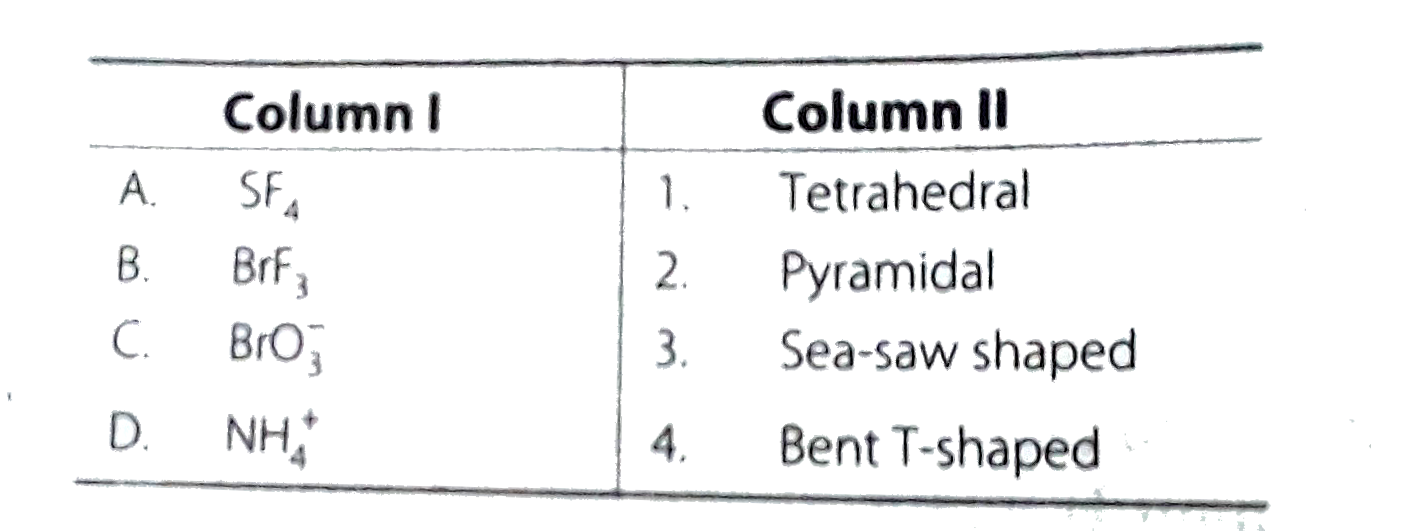Match the items of column 1 and column 2 and mark the correct option
Column 1Column 2(A)H2SO4(1)Highest electron gain enthalpy(B)CCl3NO2(2)Chalcogen(C)Cl2(3)Tear gas(D)Sulphur(4)Storage batteries
A–4, B–3, C–1, D–2
A–3, B–4, C–1, D–2
A–4, B–1, C–2, D–3
A–2, B–1, C–3, D–4
The correct Answer is:A
To solve the matching question between Column 1 and Column 2, we need to analyze each item in Column 1 and find the corresponding match in Column 2.
1. Identify H₂SO₄ (Sulfuric Acid):
- H₂SO₄ is commonly known as sulfuric acid. It is widely used in storage batteries, particularly in lead-acid batteries.
- Match: A (H₂SO₄) → 4 (Storage batteries)
2. Identify CCl₃NO₂ (Chloropicrin):
- CCl₃NO₂ is known as chloropicrin. It is often referred to as tear gas due to its irritating effects on the eyes and respiratory system.
- Match: B (CCl₃NO₂) → 3 (Tear gas)
3. Identify Cl₂ (Chlorine):
- Cl₂ is a diatomic molecule of chlorine. Chlorine is known to have the highest electron gain enthalpy among the halogens because of its small atomic size and high electronegativity.
- Match: C (Cl₂) → 1 (Highest electron gain enthalpy)
4. Identify Sulfur (S):
- Sulfur is a member of the chalcogen group in the periodic table, which includes oxygen, sulfur, selenium, tellurium, and polonium.
- Match: D (Sulfur) → 2 (Chalcogen)
Final Matching:
- A → 4 (H₂SO₄ → Storage batteries)
- B → 3 (CCl₃NO₂ → Tear gas)
- C → 1 (Cl₂ → Highest electron gain enthalpy)
- D → 2 (Sulfur → Chalcogen)
Conclusion:
The final matches are:
- A: 4
- B: 3
- C: 1
- D: 2
- H₂SO₄ is commonly known as sulfuric acid. It is widely used in storage batteries, particularly in lead-acid batteries.
- Match: A (H₂SO₄) → 4 (Storage batteries)
- CCl₃NO₂ is known as chloropicrin. It is often referred to as tear gas due to its irritating effects on the eyes and respiratory system.
- Match: B (CCl₃NO₂) → 3 (Tear gas)
- Cl₂ is a diatomic molecule of chlorine. Chlorine is known to have the highest electron gain enthalpy among the halogens because of its small atomic size and high electronegativity.
- Match: C (Cl₂) → 1 (Highest electron gain enthalpy)
- Sulfur is a member of the chalcogen group in the periodic table, which includes oxygen, sulfur, selenium, tellurium, and polonium.
- Match: D (Sulfur) → 2 (Chalcogen)
- A → 4 (H₂SO₄ → Storage batteries)
- B → 3 (CCl₃NO₂ → Tear gas)
- C → 1 (Cl₂ → Highest electron gain enthalpy)
- D → 2 (Sulfur → Chalcogen)
The final matches are:
- A: 4
- B: 3
- C: 1
- D: 2
Topper's Solved these Questions
- P-BLOCK ELEMENTSBOOK - CBSE COMPLEMENTARY MATERIALCHAPTER - P-BLOCK ELEMENTSEXERCISE - SHORT ANSWER-I TYPE QUESTIONS
51 Videos
- P-BLOCK ELEMENTSBOOK - CBSE COMPLEMENTARY MATERIALCHAPTER - P-BLOCK ELEMENTSEXERCISE - SHORT ANSWER-II TYPE QUESTIONS
34 Videos
- HALOALKANES AND HALOARENESBOOK - CBSE COMPLEMENTARY MATERIALCHAPTER - HALOALKANES AND HALOARENESEXERCISE - CONCEPTUAL QUESTIONS
10 Videos
- POLYMERS BOOK - CBSE COMPLEMENTARY MATERIALCHAPTER - POLYMERS EXERCISE - LONG ANSWER TYPE QUESTIONS
5 Videos
Similar Questions
Knowledge Check
Match the items of column 1 and column 2 and mark the correct option
Column 1Column 2(A)H2SO4(1)Highest electron gain enthalpy(B)CCl3NO2(2)Chalcogen(C)Cl2(3)Tear gas(D)Sulphur(4)Storage batteriesAA(4)B(3)C(1)D(2)BA(3)B(4)C(1)D(2)CA(4)B(1)C(2)D(3)DA(2)B(1)C(3)D(4)Match the species given in Column I with the shape given in Column II and mark the correct option.
 AA(3)B(2)C(1)D(4)BA(3)B(4)C(2)D(1)CA(1)B(2)C(3)D(4)DA(1)B(4)C(3)D(2)
AA(3)B(2)C(1)D(4)BA(3)B(4)C(2)D(1)CA(1)B(2)C(3)D(4)DA(1)B(4)C(3)D(2)Match the items of column 1 and column 2 and mark the correct option.
Column 1Column 2(A)Its partial hydrolysis does not change oxidation state of central atom(1)He(B)It is used in modern diving apparatus(2)XeF6(C)It is used to provide inert atmosphere for filling electrical bulbs(3)XeF4(D)Its central atom is in sp3d2 hybridisation(4)ArAA–1, B–4, C–2, D–3BA–1, B–2, C–3, D–4CA–2, B–1, C–4, D–3DA–1, B–3, C–2, D–4
Match the items of Column I with the items of Column II and assign the correct code:
ColumnIColumnII(A)Sapphire(1)AI2O3(B)Sphalerite(2)NaCN(C)Depresant(3)Co(D)Corundum(4)ZNS(5)Fe2O3
View SolutionMatch the items of Column I with the items of Column II and assign the correct code:
ColumnIColumnII(A)Sapphire(1)Al2O3(B)Sphalerite(2)NaCN(C)Depressant(3)Co(D)Corundum(4)ZnS(5)Fe2O3
View SolutionMatch the following
Column AColumn B(A)CuSO4()(a)Hygroscopic(B)Na2CO3⋅10H2O()(b)Deliquescent(C)ConcentratedH2SO4()(c)Efflorescent(D)ZnC12()(d)Anhydrous salt
View SolutionMatch the Column I with Column II and select the correct option.
Column IColumn IIA.10 vol H2O21.PerhydrolB.20 vol H2O22.5.358 NC.30 vol H2O23.1.785 MD.100 vol H2O24.3.03%
View SolutionMatch the compounds given in Column I with the hybridisation and shape given in Column II and mark the correct option.
Column IColumn II(A)XeF6(1)sp3d3−distorted octahedral(B)XeO3(2)sp3d2−square planar(C)XeOF4(3)sp3−pyramidal(D)XeF4(4)sp3d2−square pyramidal
View Solution

